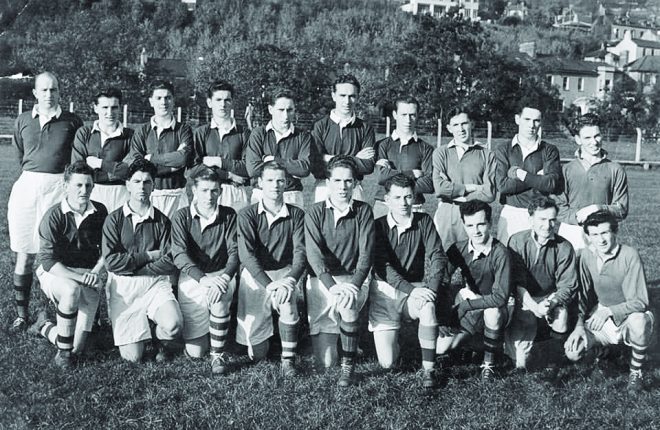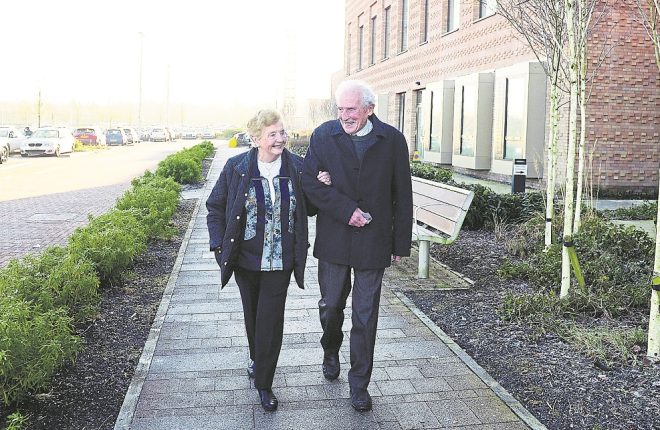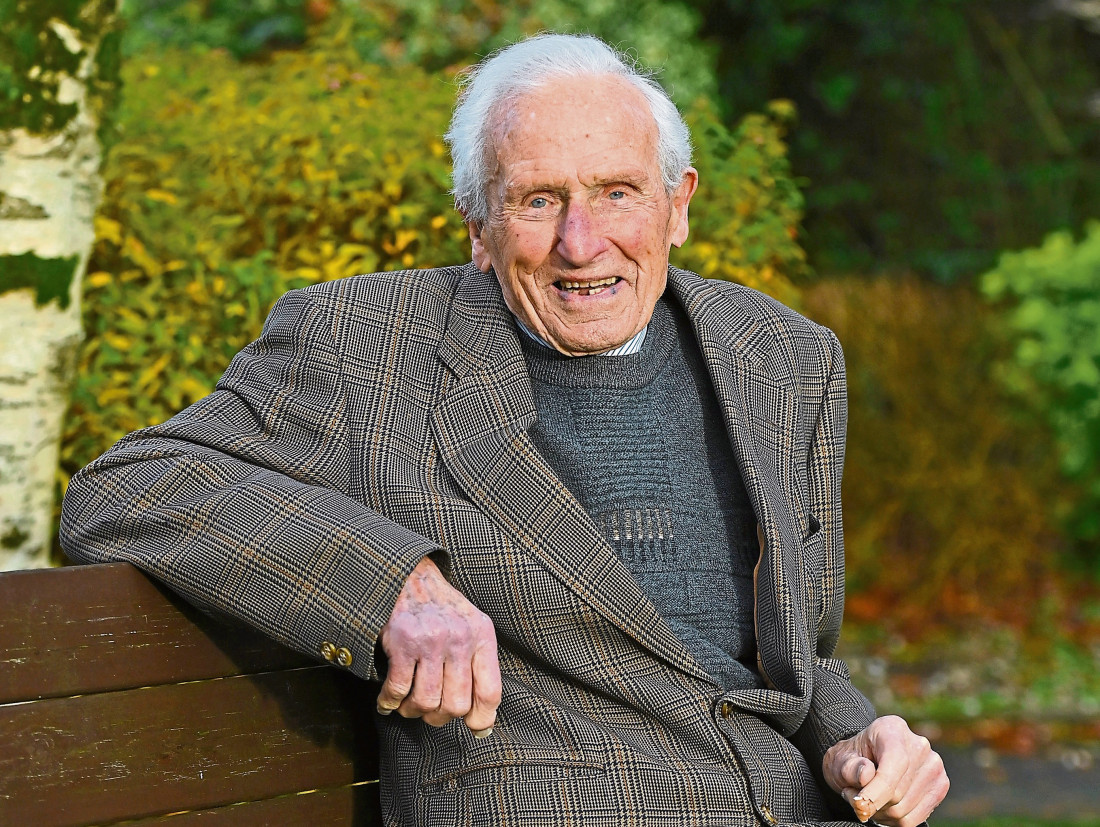Alan Rodgers talks to former Armagh and Tyrone footballer Dr Pat O’Neill about his remarkable journey through medicine and sport.
DR Pat O’Neill, a venerable figure in Omagh at 93, has been an integral part of the local community for over 70 years, leaving an indelible mark as a local GP and a multifaceted sports enthusiast.
Born in Keady in 1929, Dr O’Neill’s early life centered around family, academics and sports.
His stint at St Patrick’s College in Armagh saw him captaining the school’s football team to MacRory and Hogan Cup victories in 1946. Balancing academics and athletics, he eventually pursued a medical degree at Queen’s University in Belfast.
Amid his rise as a notable Gaelic footballer in Ulster, Dr O’Neill captained Armagh to their 1950 Ulster title triumph and played for the county in historic All-Ireland final appearance in 1953. Later, he represented Tyrone, won county medals with Omagh, St Enda’s before becoming a talented golfer while a member of Omagh Golf Club.
“I was born on March 12, 1929. Life was quiet in that part of Armagh at the time, apart from the occasional disturbance because we were so close to the border,” he recalls.
“We were coming up to the Second World War in those years…but for the most part Keady was just a normal rural town.”
At the age of ten, Dr O’Neill became a boarder at St Patrick’s College in Armagh. At that time, the college was filled with many students from the parishes of Beragh, Carrickmore and Errigal Ciaran, as well as the other parts of Tyrone which were located in the Armagh Diocese.

BACK IN THE DAY…Pat O’Neill is back row, second from left, in this photo of the Queen’s University Belfast team from 1951
While there, he briefly contemplated becoming a priest, but then turned his mind to other potential occupations.
Dr O’Neill’s talents as a footballer developed and he captained the school to their MacRory and Hogan Cup success in 1946 – a team that included Iggy Jones from Dungannon and Jim and Eddie Devlin from Coalisland.
“I remember we attended school from 9am to 3pm, got lunch and then you were free for about an hour and a half to play football. It was nearly compulsory to play,” he said.
“In my third year, I got onto the MacRory team and we won the title for three years in a row. In the final year, the Hogan Cup came into being and we won it for the first time.
“That was in 1946 and the match was in Croke Park. The priest who was there on the day gave us these vitamin tablets to keep us running. He thought they were the best thing ever, and I suppose they did help us win.”
Around the same time, the young man’s thoughts were turning towards the future. He initially contemplated becoming a vet, but a priest at St Pat’s in Armagh urged him to ‘think of human before the beast.’
As a result, he progressed to study medicine at Queen’s University in Belfast.
It was a time which coincided with his rise as one of the most prominent Gaelic footballers in Ulster, and Armagh’s sudden and surprise run to Ulster success and the verge of All-Ireland glory.
“A lot of the players at that time were college footballers which I think helped,” Dr O’Neill said.
“Cavan were the top team in Ulster, but we beat them in 1950 at Clones and I was captain.
“Then we lost fairly heavily in the All-Ireland semi-final. The people of the county thought we were over-trained.
“But it was a big achievement to then reach the All-Ireland final in 1953. I remember we went into collective training for ten days in Maghery. The training at that time was nothing like the intense regime and diets that players have now – the only diet for us was maybe to cut down on the alcohol for those who drank.
“There was great excitement and the build-up to the final was enormous. Poor old Bill McCorry missed a penalty in the final and I think it was the first one he’d missed all year. He was playing soccer as well at the time, so we felt he would be good at the penalties.
“We were all disappointed, even though I think people were content that we had put on a good show in the final.”
***
Amidst the fervour of football, destiny intervened in the form of an offer to work at the Tyrone County Hospital in Omagh for the newly-graduated doctor.
The combination of a burgeoning medical career and a love for football marked the next chapter in Dr O’Neill’s journey.
“I was at Queen’s doing my final exams, and a cousin of mine was Dr Bill McMullan, who was a GP in Omagh. His brother, Mickey, was a teacher and very keen on the dogs.
“He had a number of greyhounds and encouraged me to go to a race meeting in Omagh and back one of his dogs,” recalls Dr O’Neill.
“While I was there, Dr McMullan asked me what I was working at. I told him I’d probably be repeating my final exams and he said that if I passed there’d be a job for me in Omagh.
“So I got the exam and came to Omagh in the summer of 1952.”
Dr O’Neill’s arrival marked the start of a lifelong career in his adopted town. As his work as a GP evolved, he found that it occasionally impinged on his ability to maintain his commitment to Gaelic football.
Nevertheless, by 1956, he was a panel member of the first Tyrone team to win the Ulster senior title and a key member of the Omagh team which had just won three county titles in a row
“I didn’t have much time, and it wasn’t easy to get away from the practice,” he remembers.
“On many days I was going out to work after being up three quarters of the night with a patient, often in the rural areas of the Omagh district.
“At that time, maternity work was based in the district before it changed and people came to hospital. There was a lot of night work which was difficult enough to manage. There were times when I’d have just returned home from a rural visit and the phone would ring… then I’d have to go straight back out again.”
***
Still, as time progressed, Dr Pat O’Neill, established his own practice and over the subsequent decades he earned a trusted reputation for the care and attention he provided to his many patients.
As his Gaelic footballing career edged towards a conclusion, Dr O’Neill married Agnes Cunningham at the Sacred Heart Church in 1959.
Agnes worked for many years at St Brigid’s High School, and the couple were blessed with seven daughters.

ARM IN ARM…Dr Pat O’Neill with his late wife, Agnes
“We met at a dance and then things got serious,” he smiled. “We had seven daughters and Agnes did a good job of raising them when I was out and about.”
Dr Pat and Agnes were married for 63 years before his wife sadly died in 2022.
The couple were among the first to receive the Covid vaccine locally in 2020 and, given his professional interest, Dr O’Neill is acutely aware of how the pandemic has impacted upon the health profession.
“Being a GP in a local practice has become a lot more pressurised over time,” he said.
“Even years ago, there was a lot expected from us and the night work was difficult to manage.
“But obviously things have changed greatly since the Covid pandemic.
“In my time working, patients could make appointments and get seen to quickly. Unfortunately, it is no longer like that anymore.”
As Dr O’Neill prepares to mark his 94th birthday in March, his legacy extends beyond the accolades on the sports field; it encompasses a lifetime of service, care, and an indomitable spirit that is still very much evident.
“I’ve had so many wonderful experiences, and made lifelong friends along the way, which have helped keep me going,” he smiled.
Receive quality journalism wherever you are, on any device. Keep up to date from the comfort of your own home with a digital subscription.
Any time | Any place | Anywhere












